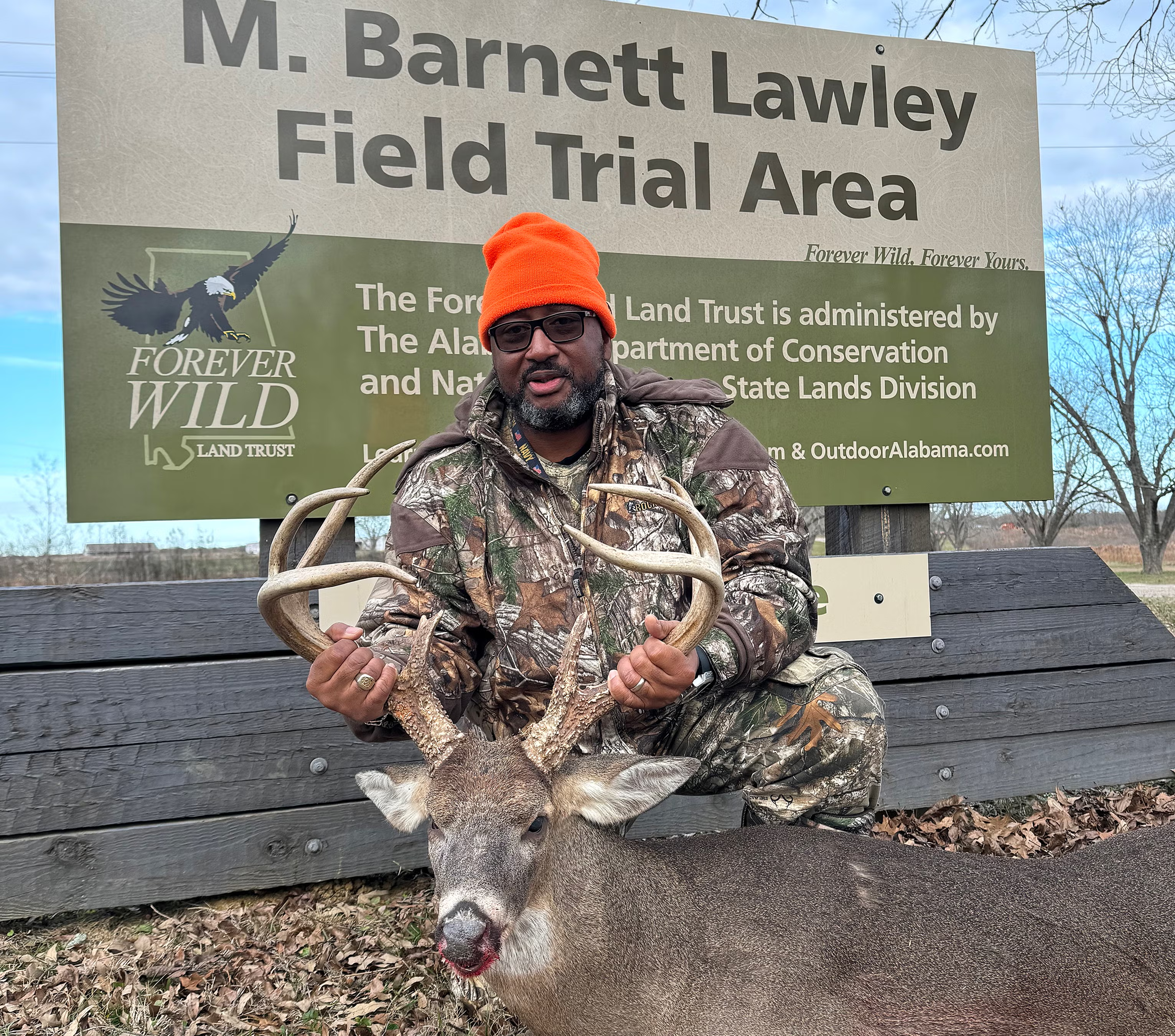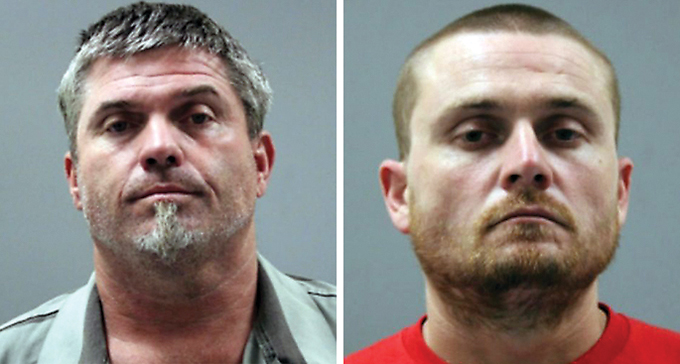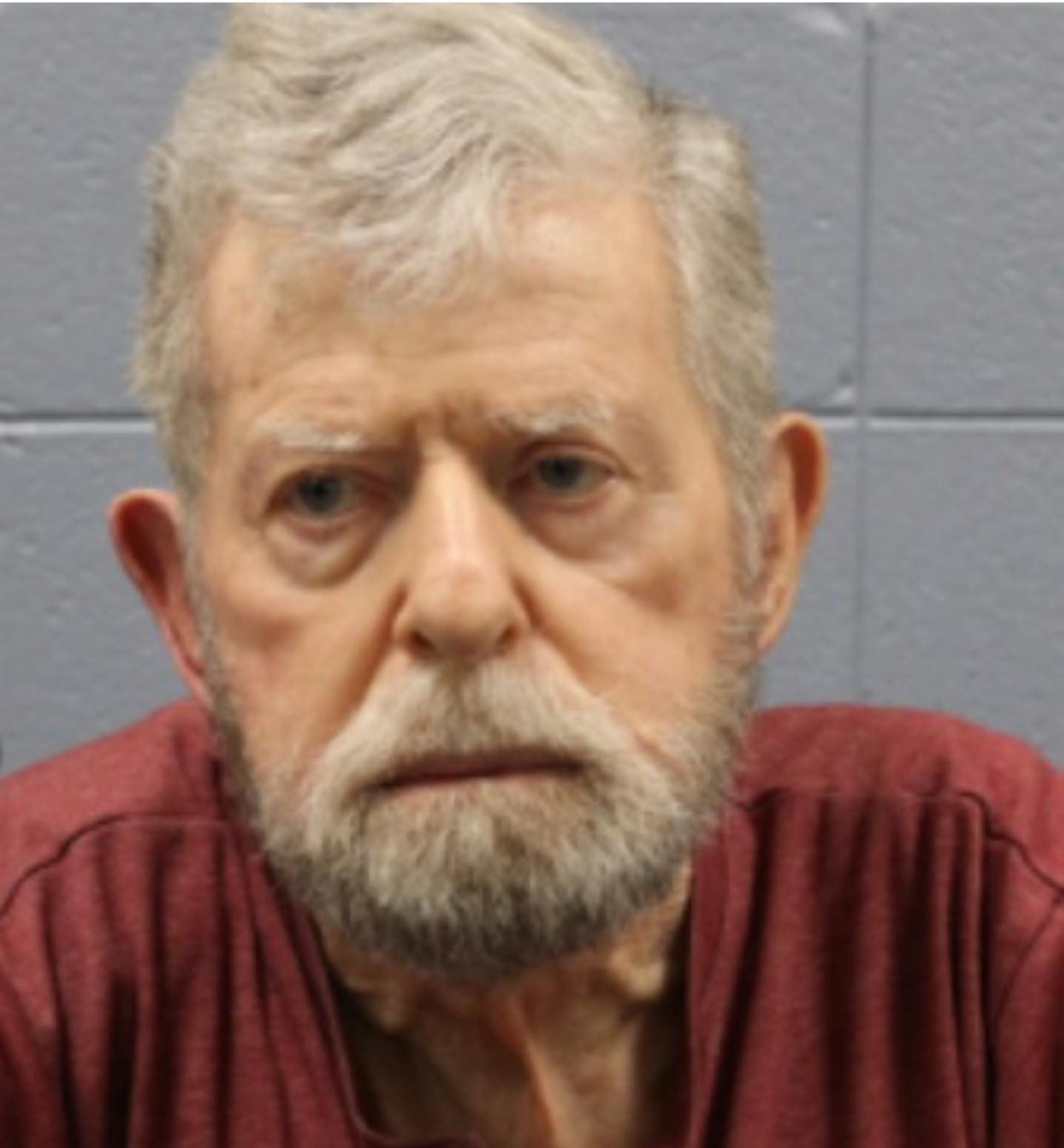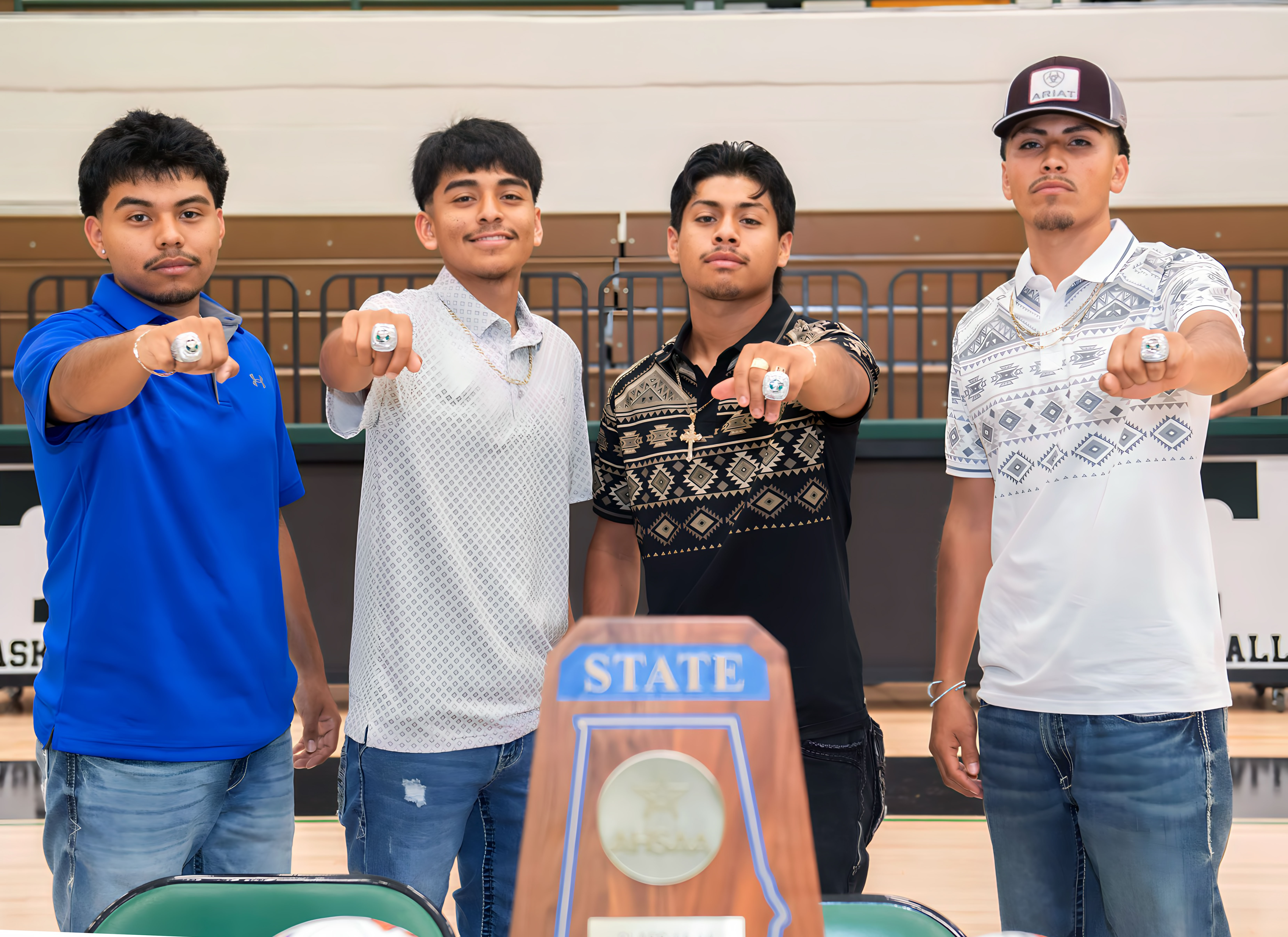Get Outdoors: Forever Wild’s Lawley Field trial area offers variety of outdoor recreation
Published 11:40 am Friday, January 24, 2025

- Retired disabled Navy veteran Lamar Coleman bagged this beautiful buck on a Field Trial Area hunt. ADCNR photo
You might think Forever Wild Land Trust’s M. Barnett Lawley Field Trial Area is all about sporting dogs, but it’s much, much more. The 4,323-acre property in Hale County, managed by the Alabama Department of Conservation and Natural Resources’ State Lands Division, is indeed one of the premier competitive sporting dog event areas in the Southeast, and it also provides numerous outdoor recreational opportunities for youth and physically disabled hunters, beginner anglers, and bird-watching enthusiasts as well as field-based learning opportunities for college students.
ADCNR Commissioner Chris Blankenship said the Field Trial Area, which was once the State Cattle Ranch, is about to get even better with a $3 million investment in infrastructure being used to establish a new event center with an adjacent outdoor pavilion and restrooms. Restrooms have also been added in the Field Trial Areas as well as a large expansion in the paddock and barns for events that use horses. Funds for the work come from multiple sources, including Innovate Alabama, the State Legislature, the Forever Wild Stewardship Fund and ADCNR.
“I think it’s important for the public to know that we manage the property for multiple priorities,” Blankenship said. “We have youth fishing events. We have youth duck hunts. We have youth dove hunters. We have youth and physically disabled deer hunts in addition to the 30-plus competitive sporting dog events a year. We even serve as a stop along the Black Belt Birding Festival. It is truly a multi-purpose area enjoyed by more than 3,850 visitors each year. The infrastructure improvements will really set the Field Trial Area as the premier location for outdoor recreation in the Black Belt.”
Trending
State Lands Division Director Patti McCurdy is proud of the ongoing efforts of her staff to manage the property for the benefit of multiple user groups.
“Managing the property with a goal of not just expanding public access but also providing a wide range of outdoor recreation opportunities requires a lot of planning and hard work,” McCurdy said. “My staff does a great job of furthering ADCNR’s efforts to enhance conservation habitats and expand public access in a manner that also delivers a positive economic impact to surrounding communities.”
Jeremy Doss, Chief Enforcement Officer with State Lands, said State Lands is working diligently to enhance the habitat for multiple species, turning what was once a cattle ranch with abundant pastures into a haven for wild game and an area of thriving native prairie grasslands.
“When the Department of Corrections owned the property, there was already a physically disabled hunting area on the property,” Doss said. “We do all the youth hunts and operate the physically disabled hunts in the interior. The physically disabled area has a lot of edges, mixed stand of hardwoods and pines, three green fields and three physically disabled-access shooting houses.”
Doss said all three stands are typically filled for each hunt. Visit www.alabamaforeverwild.com/news/lawley-field-trial-area-hunts and click on the link to register for the physically disabled hunts and youth hunts.
One hunter who recently took advantage of the physically disabled hunting program was disabled Navy veteran Lamar Coleman from Pell City, who bagged what just about every hunter would consider to be a trophy buck, the huge, symmetrical eight-point seen in the photo.
Trending
Coleman was sitting in the stand where he had hunted before with little success.
“I’ve been hunting this property since 2017,” he said. “I’ve only seen one other buck sitting in that house. It was a big six-point that I didn’t take a shot at, but he was looking back, and I thought a bigger deer was coming. But nothing came out, and the six-point got away. I didn’t actually shoot a deer there until 2023, and it was a doe.”
During his most recent hunt, Coleman was watching a cut-through lane that the deer often use to travel between fields.
“I’m facing that way, watching that lane to the right,” he said. “Then out of the corner of my eye to the left, I see movement. I thought to myself there’s no way a deer is coming from that direction. It’s broad daylight, so I eased back to the left and looked. He walked out and was looking to his left. He didn’t pay me any attention at all. I guess there were some other deer crossing in the thicket over there.
“I could see his rack, but I couldn’t tell how may points he had. And I could only see the top of his shoulder because of the grass. He was standing in a little dip. I thought, ‘Man, if I don’t take this shot, I might not get another one.’’’
Coleman put the crosshairs on the deer’s shoulder and pulled the trigger. The deer bolted straight ahead.
“I dropped my magazine, emptied the chamber and walked down there,” he said. “I couldn’t find any blood.”
Coleman called State Lands’ Hayden Peacock, who helps facilitate the hunting on the grounds, for help in locating the buck.
“I told Mr. Peacock that I got a good hit on him,” Coleman said. “He came down and we looked for 15 minutes. I showed him the video, and he kept walking until he finally found a speck of blood. Then we found a splatter here and there.”
The two decided to split up to continue the search, and it wasn’t long before Coleman found another piece of evidence of which way the deer went.
“I said, ‘Man, there’s a pine tree knocked over right here,’’’ he said. “Then we walked right up on him. I think Mr. Peacock was more excited than I was. I’m so glad they’ve got these opportunities for us, being disabled, especially being a retired disabled Navy vet. I’ve been coming twice a year since 2017. I love it.”
Doss said as good as Coleman’s buck was, he thinks the Field Trial Area has the potential to yield more big bucks this year and in years to come.
“Before the season is out, I expect to see another one or two like that,” Doss said. “There are some really large specimens on that area. Coleman’s deer was a real stud.”
Commissioner Blankenship agreed the Field Trial Area has big buck habitat.
“It has some swampy areas that we are leaving uncut and wild, so we have habitat for the deer,” Commissioner Blankenship said. “Seeing these big deer shows how effective we have been managing for different species. Diversifying the use of the property for multiple user groups is good for the public.”
In addition to the physically disabled hunts, the Field Trial Area hosts a series of youth hunts, which are typically scheduled on Wednesdays and Saturdays unless there is a conflict with a national sporting dog event. The area has 14 green fields for the youth hunts, and the fields are rotated to limit the pressure on the deer.
Doss or one of his team places the youth hunters in the stands for the morning hunt.
“Kids can come there with the expectation of seeing the biggest deer they’ve ever seen in their lives,” he said. “We have deer on field cameras that are giants. We don’t overload the place so we can maintain the quality.”
Doss said kids who are selected through the random draw process for the duck hunts can expect a similar experience.
“We’re really working hard on converting some of the commercial catfish ponds into moist soil management for ducks,” he said. “State Lands Conservation Officer David Hopper has been working really hard on that. We’re making real good progress on that.
“Some of the duck hunts are phenomenal. It’s not just wood ducks. We have mallards, gadwalls, you name it. We’re on the edge of the Tombigbee River flyway. There are commercial catfish operations all around us, and we’re manipulating our place for a food source. We’re really a honey hole for ducks.”
Doss said State Lands’ commitment to habitat work has resulted in the success rates of deer and duck hunters.
“We were in a situation where we were doing a lot of bush hogging and now, we’re in a prescribed burn rotation,” he said. “We leave some areas fallow before we burn. When it was a cattle ranch, the limiting factor was lack of cover. We’re manipulating the habitat to provide cover. We’re also answering the Forever Wild call for our native grasses. We are actively working to turn some old cow pastures into native grasses. By using fire instead of a bush hog, we have a tremendous amount of native grasses that are really showing out.”
Director McCurdy echoed Commissioner Blankenship on what the new event center and pavilion are going to mean to the Field Trial Area.
“In addition to helping us accommodate ADCNR’s youth and collegiate programs, the event complex will provide meeting space and generally support all aspects of what the sporting dog groups need to conduct various training and competition event activities,” McCurdy said. “This will give us the capacity to draw more national events. It’s going to make us a destination in the sporting dog world.”
“Even with our currently limited infrastructure, this unique property is already being recognized as a national event venue. We will be serving as the host site for both the AKC National Gun Dog Championship and the AKC National Vizsla Gun Dog Championship over the next couple of months. Once completed, the new event complex will raise the Field Trial Area’s national profile and bring in even more visitors to surrounding communities.”
The education aspect of the Field Trial Area involves ADCNR’s Wildlife and Freshwater Fisheries Division and its Campus Conservation Program, headed by Sgt. Bill Freeman. Some of the colleges and universities participating in the program include Auburn University, Tuskegee University, Montevallo University, Alabama A&M University, Alabama State University, Jacksonville State University, the University of Alabama-Huntsville and Calhoun Community College.
“We’re bringing in biology major college students from institutions across Alabama to the Field Trial Area, giving them a taste of the habitat work in the duck ponds and prescribed fire,” Doss said. “We’re also bringing them in for things like a duck hunt or fishing event. Some of these students who are going into these biology and wildlife programs don’t have actual experience in the outdoors. We’re finding those students. Bill and I have worked very closely on this. We’re bringing these students out and letting them get their hands dirty.”
From January 31 through February 8, the AKC National Gun Dog Championship will showcase pointing dogs from all over the nation competing for titles.
The Campus Conservation Program will be at the Field Trial Area from January 24-26, while youth deer, youth duck and physically disabled hunts are set for January 25. On January 29, youth deer and physically disabled hunts are scheduled.
“Every Wednesday and Saturday, I’m waiting to hear about a youngster killing a monster,” Doss said. “These pictures of deer and the deer these hunters have taken make this place a phenomenal youth hunting area. I think it’s the best youth hunting place in the Southeast, easy.”
David Rainer is an outdoors writer for Alabama Department of Conservation and Natural Resources.





